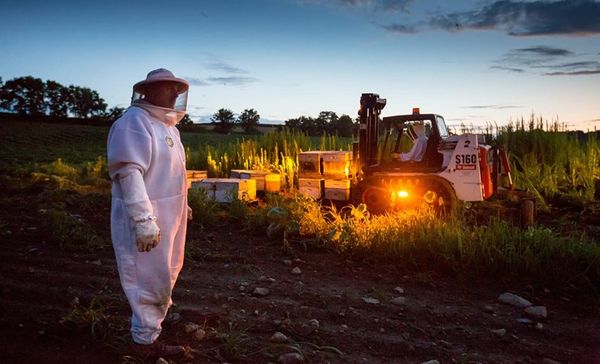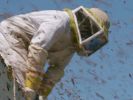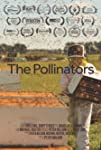Eye For Film >> Movies >> The Pollinators (2019) Film Review
The Pollinators
Reviewed by: Jennie Kermode

Did you know that of all the flowering crops that humans eat, 80% are pollinated by bees? From apples, mangoes, Brazil nuts and cashews to buckwheat, turnips and marrows, many vital food sources depend on them - but if you've been paying attention, you'll know that bee populations are in decline. Part of the blame for this has been laid at the feet of travelling beekeepers who transport their hives to and fro across the US each year to provide support to farmers where there are not enough bees locally. Nonsense, they say in this documentary. They've been doing this since the Fifties. They care about their bees, and they know that something else is wrong.
If you doubt that assertion on first reading it, Peter Nelson's film lets you see it on their faces. There are no big gestures here, just tired men unused to displaying emotion in public whose distress is all too visible as they watch bees returning from the fields collapse on the ground beside their truck, unable to make that final effort and get back into their hives, where workers are busily pushing out those who have died within. They're trying to keep the whole thing going by splitting up the hives, starting them off with new queens, but they don't see it as sustainable. Each night, as dusk sets in, they wait for the last of the workers to get home, and each night there are fewer of them.

Why are travelling bees necessary? The answer lies in that fount of so many problems with US agriculture: monocultures. When agriculture is treated like factory work, sized up for economies of scale, natural mechanisms break down. Nelson shows us almond trees in blossom in California - February's crop, the first of the year. The sight ought to be beautiful, but as he pulls the shot back, revealing a surreal landscape with nothing but pink visible for miles, one might be reminded of the alien red weed in HG Wells' War Of The Worlds. There is nothing here but almonds, and that means that when February is over, bees have nothing to eat.
Huge swathes of the continent now look like this. It makes life easy for diseases which pass between plants, and this in turn necessitates heavier pesticide use, with several popular pesticides having been demonstrated again and again to be toxic to bees. Other chemicals used by farmers also have damaging effects, such as one used to thin out apple trees so that clusters of flowers don't produce clusters of smaller fruits (usually much tastier, in this reviewer's opinion) but instead fall away to produce single, larger fruits which match the archetype that American shoppers are expected to find most desirable. Some farmers keep this on hold, we are told here, until the bees have been and gone - but that's not much help if a neighbour just along the road is spraying already, because the bees don't know where one farm ends and another begins.
There are alternative ways of farming and some of those are touched on here, but whilst these might provide sanctuary for isolated bee populations, the issues of how to sustain travelling bee populations remains. A variety of interviewees reflect on this and explain the complex of different, intersecting problems affecting bees today. Scientists, academics and campaigners provide the theory whilst farmers explain how the situation is impacting them at ground level. There's not a huge amount here that's likely to be new to people with a sustained interest in these issues, but what Nelson does well is to demonstrate the vast scale of the problem and the urgency of implementing solutions. In so doing, he reaches out directly to viewers concerned about their own food choices, and also contributes to the mounting weight of evidence on the side of those pushing for reform.
Reviewed on: 13 Jun 2020

















